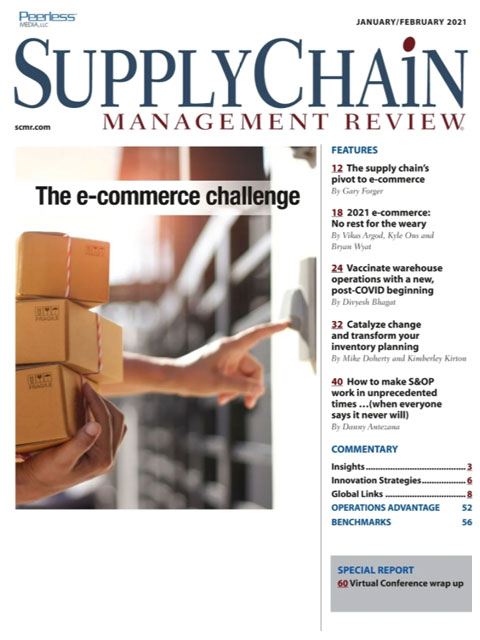Sorry, but your login has failed. Please recheck your login information and resubmit. If your subscription has expired, renew here.
January-February 2021
This morning, I turned on the television and watched the first stretch-wrapped pallets of the just-authorized vaccine being loaded onto a truck at a Pfizer plant in Michigan. From there, the pallets were headed to FedEx’s logistics hub in Memphis where they would be delivered to 153 locations across the 50 states. The event was both historic and mundane: Historic in that the shipments represent the hope of a nation that in the coming months, we’ll begin to put 2020—and COVID—in the rearview mirror; mundane in that this is a scene repeated millions of times a day, without fanfare, in plants and distribution centers across the country. Two of… Browse this issue archive.Need Help? Contact customer service 847-559-7581 More options
Business leaders and consumers alike have observed the ubiquity of e-commerce brought on by the COVID-19 pandemic. At this juncture, that is not news. Well, how about this: According to IBM’s U.S. Retail Index, the coronavirus accelerated the shift toward online shopping—and away from brick-and-mortar—by about five years.
This news may be good for a company’s top line; however, many supply chain leaders are struggling to cope with the tremendous pressure this surge has put on their internal operations, customer service, and delivery partners. Both manufacturers and retailers, faced with e-commerce volumes that no one anticipated until 2025, are trying to meet this outsized demand with networks that were not prepared to handle this much volume this soon for such an extended period.
So then, the questions on many minds are these: How can existing supply chains rapidly mature to the same five-year future level? And how can a business rise to the current challenges with only the resources at hand?
Like most supply chain decisions, the answers to these questions are found at the intersection of speed and cost. In the realm of e-commerce, pioneers like Amazon relentlessly favored speed. That worked fine for brick-and-mortar retailers when their e-commerce volumes were in the single digits as a percentage of sales. However, given that today’s order volumes are likely here to stay, profitability is a mandatory consideration from here on out.
Last-mile delivery
A simple, back of the envelope SWOT analysis will tell you that retailers with brick-and-mortar stores have an obvious advantage over their direct-to-consumer (D2C) counterparts: their physical store footprint. Several last mile delivery innovations have spawned from this advantage, including buy online, pick-up in store and buy online, ship from store. Another model that is growing in popularity for both traditional and D2C retailers is the micro-fulfillment center (also referred to as an urban DC).
Buy online, pick-up in store (BOPIS) and the more social distancing-friendly adaptations like “curbside pickup” have seen wider adoption in recent years, but particularly since the start of the pandemic. BOPIS is relatively inexpensive for traditional retailers as the last mile delivery cost is split with the customer.

This complete article is available to subscribers only.
Log in now for full access or start your PLUS+ subscription for instant access.
SC
MR
Sorry, but your login has failed. Please recheck your login information and resubmit. If your subscription has expired, renew here.
January-February 2021
This morning, I turned on the television and watched the first stretch-wrapped pallets of the just-authorized vaccine being loaded onto a truck at a Pfizer plant in Michigan. From there, the pallets were headed to… Browse this issue archive. Access your online digital edition. Download a PDF file of the January-February 2021 issue.Business leaders and consumers alike have observed the ubiquity of e-commerce brought on by the COVID-19 pandemic. At this juncture, that is not news. Well, how about this: According to IBM’s U.S. Retail Index, the coronavirus accelerated the shift toward online shopping—and away from brick-and-mortar—by about five years.
This news may be good for a company’s top line; however, many supply chain leaders are struggling to cope with the tremendous pressure this surge has put on their internal operations, customer service, and delivery partners. Both manufacturers and retailers, faced with e-commerce volumes that no one anticipated until 2025, are trying to meet this outsized demand with networks that were not prepared to handle this much volume this soon for such an extended period.
So then, the questions on many minds are these: How can existing supply chains rapidly mature to the same five-year future level? And how can a business rise to the current challenges with only the resources at hand?
Like most supply chain decisions, the answers to these questions are found at the intersection of speed and cost. In the realm of e-commerce, pioneers like Amazon relentlessly favored speed. That worked fine for brick-and-mortar retailers when their e-commerce volumes were in the single digits as a percentage of sales. However, given that today’s order volumes are likely here to stay, profitability is a mandatory consideration from here on out.
Last-mile delivery
A simple, back of the envelope SWOT analysis will tell you that retailers with brick-and-mortar stores have an obvious advantage over their direct-to-consumer (D2C) counterparts: their physical store footprint. Several last mile delivery innovations have spawned from this advantage, including buy online, pick-up in store and buy online, ship from store. Another model that is growing in popularity for both traditional and D2C retailers is the micro-fulfillment center (also referred to as an urban DC).
Buy online, pick-up in store (BOPIS) and the more social distancing-friendly adaptations like “curbside pickup” have seen wider adoption in recent years, but particularly since the start of the pandemic. BOPIS is relatively inexpensive for traditional retailers as the last mile delivery cost is split with the customer.
SC
MR


Latest Supply Chain News
- April Services PMI declines following 15 months of growth, reports ISM
- Attacking stubborn COGS inflation with Digital Design-and-Source-to-Value
- Despite American political environment, global geopolitical risks may be easing
- Joseph Esteves named CEO of SGS Maine Pointe
- Employees, employers hold divergent views on upskilling the workforce
- More News
Latest Podcast

 Explore
Explore
Software & Technology News
- Technology’s role in mending supply chain fragility after recent disruptions
- Tech investments bring revenue increases, survey finds
- Survey reveals strategies for addressing supply chain, logistics labor shortages
- AI, virtual reality is bringing experiential learning into the modern age
- Humanoid robots’ place in an intralogistics smart robot strategy
- Tips for CIOs to overcome technology talent acquisition troubles
- More Software & Technology
Latest Software & Technology Resources

Subscribe

Supply Chain Management Review delivers the best industry content.

Editors’ Picks






